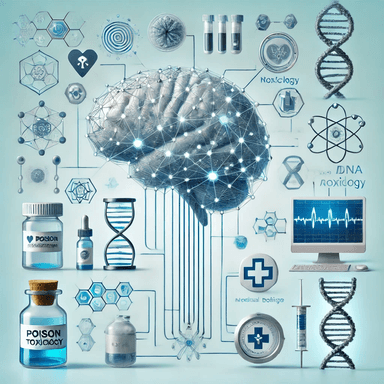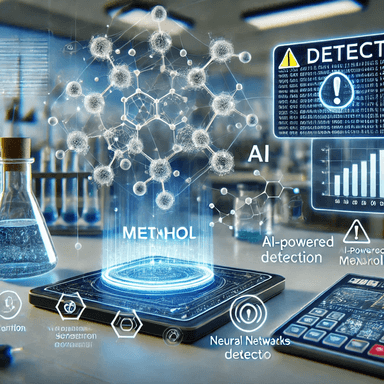The Intersection of Machine Learning and Poisoning Cases: A New Era in Predictive Healthcare
Omid Mehrpour
Post on 23 Aug 2024 . 9 min read.
Omid Mehrpour
Post on 23 Aug 2024 . 9 min read.

Machine learning and healthcare fusion have sparked revolutionary advancements across various medical fields in recent years. One area where this convergence has shown immense promise is toxicology. Poisoning cases, which can present with rapidly deteriorating conditions, demand timely and accurate interventions. Machine learning (ML) in healthcare transforms toxicology by offering predictive analytics that help clinicians assess risks, personalize treatments, and even detect poisons more efficiently. Integrating data-driven toxicology into clinical decision support systems (CDSS) is reshaping public health strategies, ensuring that individual and broader populations benefit from these cutting-edge innovations.
Machine learning's role in toxicology is particularly vital as it can handle the complexity and variability of poisoning cases—ranging from methanol and organophosphate poisoning to environmental toxins. Traditional approaches often rely on a clinician's experience and relatively static clinical guidelines. However, AI-powered tools can analyze large datasets and uncover subtle patterns that may not be evident through conventional methods. This ability to "learn" from vast amounts of data and predict outcomes makes machine learning a powerful tool in managing poisoning cases.
The significance of predictive healthcare models becomes clear when considering their potential in life-or-death situations. For example, in cases of acute diquat poisoning—a highly toxic herbicide—AI models have demonstrated remarkable accuracy in predicting death risk, far surpassing traditional assessment methods. This predictive capability enables clinicians to make informed decisions early, which is crucial in critical care. Furthermore, these models are not just abstract tools; they are designed with interpretability in mind, thanks to frameworks like SHapley Additive ExPlanations (SHAP), which ensure that AI recommendations are understandable and actionable by healthcare professionals.
Beyond predicting outcomes, machine learning is also proving invaluable in specific poisoning scenarios. From methadone poisoning amidst the opioid crisis to mushroom poisoning in regions with endemic exposure, AI applications are enhancing early detection and personalized treatment plans. These advancements allow for rapid triage and intervention, improving survival rates and reducing long-term complications. Additionally, machine learning addresses broader social and environmental factors contributing to poisoning incidents, offering new avenues for public health interventions.
This blog post will explore how machine learning is applied to poisoning cases, exploring its role in predictive healthcare, personalized treatment, poison detection, and addressing social vulnerabilities. Drawing on recent studies, we will illustrate how AI is becoming an indispensable tool in modern toxicology and why healthcare professionals should consider integrating these technologies into their practice.
Machine learning models have shown immense potential in predicting death risks associated with poisoning, a crucial advancement in toxicology. Acute poisoning cases, such as those involving diquat, methanol, and organophosphates, often require rapid assessment and intervention. ML models outperform traditional methods to identify critical risk factors and predict patient outcomes.
Related blog: How AI is Revolutionizing Medical Toxicology: Exploring AI-Enhanced Diagnosis, Predictive Analytics, and Poison Control
ML model accuracy in predicting diquat poisoning outcomes
In the case of acute diquat (DQ) poisoning, where the fatality risk is high, machine learning offers a lifeline. A 2024 study used various ML techniques to predict death risks, including logistic regression, random forest, and gradient boosting. The results were striking, with models achieving area Under the Curve (AUC) values as high as 0.98, indicating near-perfect predictive accuracy (Li et al., 2024). By integrating SHAP for interpretability, these models can guide clinicians in tailoring personalized treatment strategies, offering hope in otherwise grim scenarios.
Methanol poisoning, often resulting from accidental ingestion of adulterated alcohol, poses another challenge. A 2024 study applied machine learning models like Gradient Boosting Classifiers to predict poisoning severity, achieving AUC values of 0.947 and 0.943 (Rahimi et al., 2024). These models identified critical predictors, such as the patient's age, the amount of methanol ingested, and respiratory symptoms, allowing for more precise risk assessments. The ability of AI to predict outcomes and personalize treatment plans is vital in preventing the severe metabolic acidosis and vision loss commonly associated with methanol poisoning.
Organophosphate poisoning, often linked to pesticide exposure, requires quick action to prevent fatal outcomes. A 2023 study utilized the XGBoost model to predict severe cases by analyzing factors like venous blood gas-pH and plasma cholinesterase activity (Hosseini et al., 2023). With early risk identification, healthcare providers can intervene sooner, significantly reducing mortality rates.
Machine learning's adaptability allows it to tackle various poisoning scenarios, offering tailored solutions that enhance patient care. These AI-driven insights are beneficial in clinical settings and pave the way for broader public health applications.
Amidst the ongoing opioid crisis, methadone poisoning has become a prevalent concern. Machine learning models like Light Gradient Boosting Machine (LGBM) and XGBoost have accurately predicted outcomes in methadone poisoning cases (Mehrpour et al., 2023). These models provide clinicians with critical insights, enabling more precise and personalized treatment plans that can mitigate the risk of overdose and reduce fatal outcomes.
Mushroom poisoning, which can range from mild gastrointestinal distress to severe liver failure, benefits significantly from early triage using machine learning. A 2023 study highlighted the effectiveness of the XGBoost model in identifying critically ill patients, allowing for rapid intervention (Liu et al., 2023). In regions where foraging is common, such predictive tools are essential in improving survival rates.

Beyond individual poisoning cases, machine learning is making strides in environmental toxicology. For instance, random forest models have been employed to study the impact of soil acidity and metalloid poisoning on soil microbiomes in contaminated areas (Chakraborty et al., 2024). These insights are crucial for developing sustainable practices that prevent environmental poisoning, ultimately protecting human health.
Machine learning's influence extends beyond clinical toxicology to address environmental and social determinants of health. AI can help craft targeted public health interventions by identifying high-risk populations and areas.
In the United States, machine learning models have been used to analyze social vulnerability factors contributing to drug poisoning mortality. A 2023 study identified predictors like disability prevalence, population density, and minority status, offering valuable insights for public health officials aiming to reduce disparities in drug-related deaths (Tatar et al., 2023).
In Europe, AI tools are increasingly being applied to manage poisoning cases, particularly in rural and urban hospitals with varying healthcare challenges. Similarly, localized AI solutions in Asia address unique toxicology challenges, from environmental toxins to industrial exposure. These models are being adapted to the specific needs of these regions, showcasing the versatility of machine learning in healthcare.
Environmental toxicology also benefits from machine learning. A 2024 study used random forest models to explore how soil acidity and metalloid poisoning affect soil microbiomes in mining-contaminated areas (Chakraborty et al., 2024). These data-driven insights are essential for developing sustainable agricultural practices that can prevent poisoning at the environmental level.
In addition to predicting outcomes and assessing risks, machine learning drives innovation in poison detection. AI-powered tools offer faster and more accurate methods for identifying poisons, crucial for early intervention and prevention.

One of the most exciting developments in poison detection is using nanosensors combined with AI to detect methanol in alcoholic beverages. A 2022 study introduced a nanosensor-based system that uses thermal gradients and machine learning algorithms for rapid, cost-effective methanol detection (Tonezzer et al., 2022). This technology is particularly vital in regions where illicit alcohol consumption poses a significant health risk.
Related blog: Advanced AI Solutions in Medical Toxicology
Childhood lead poisoning remains a critical public health issue, especially in areas with older infrastructure. A 2020 study demonstrated that machine learning models, particularly random forest, outperformed traditional methods in predicting elevated blood lead levels (Potash et al., 2020). Early detection through AI can lead to timely interventions, preventing lead exposure's long-term cognitive and behavioral impacts.
AI models like XGBoost and random forest have shown high accuracy in detecting antihyperglycemic agent poisonings, such as those involving biguanides and sulfonylureas. These models assist physicians in making more informed decisions, particularly in complex cases where poisoning symptoms may overlap with other conditions (Mehrpour et al., 2023).
The integration of machine learning into toxicology marks a significant milestone in the evolution of healthcare. From predicting death risks in acute poisoning cases to innovating poison detection methods, AI is indispensable in saving lives and improving patient outcomes. As these models evolve, their applications will only expand, offering even more precise, personalized, and preventive care.
For healthcare professionals, embracing machine learning tools in toxicology could lead to more accurate diagnoses, tailored treatment strategies, and better patient care. Public health officials can harness the power of AI to address social and environmental determinants of health, creating targeted interventions that reduce poisoning risks. Globally, machine learning is already shaping the future of toxicology, with innovations that cater to the unique challenges of different regions, from the United States to Europe and Asia.
As we look toward the future, the intersection of machine learning and toxicology promises a new era of predictive healthcare—one that is reactive and proactive in preventing poisoning cases and improving overall public health.
Call to Action: If you are a healthcare professional, consider how machine learning can enhance your toxicology practice. Public health officials should explore AI tools to address social and environmental factors in poisoning cases. By adopting these innovations, we can revolutionize healthcare and save lives.
Recommended Reading:
© All copyright of this material is absolute to Medical toxicology
Dr. Omid Mehrpour (MD, FACMT) is a senior medical toxicologist and physician-scientist with over 15 years of clinical and academic experience in emergency medicine and toxicology. He founded Medical Toxicology LLC in Arizona and created several AI-powered tools designed to advance poisoning diagnosis, clinical decision-making, and public health education. Dr. Mehrpour has authored over 250 peer-reviewed publications and is ranked among the top 2% of scientists worldwide. He serves as an associate editor for several leading toxicology journals and holds multiple U.S. patents for AI-based diagnostic systems in toxicology. His work brings together cutting-edge research, digital innovation, and global health advocacy to transform the future of medical toxicology.
Li H., Liu Z., Sun W., Li T., & Dong X. (2024). Interpretable machine learning for the prediction of death risk in patients with acute diquat poisoning. Scientific Reports, 14(1), 16101. https://doi.org/10.1038/s41598-024-67257-6.
Rahimi M., Hosseini SM., Mohtarami SA., et al. (2024). Prediction of acute methanol poisoning prognosis using machine learning techniques. Toxicology, 504, 153770. https://doi.org/10.1016/j.tox.2024.153770.
Mehrpour O., Saeedi F., Vohra V., et al. (2023). Outcome prediction of methadone poisoning in the United States: Implications of machine learning in the National Poison Data System (NPDS). Drug and Chemical Toxicology. https://doi.org/10.1080/01480545.2023.2277128.
Hosseini SM., Rahimi M., Afrash MR., et al. (2023). Prediction of acute organophosphate poisoning severity using machine learning techniques. Toxicology, 486, 153431. https://doi.org/10.1016/j.tox.2023.153431.
Liu Y., Lyu X., Yang B., et al. (2023). Early triage of critically ill adult patients with mushroom poisoning: Machine learning approach. JMIR Formative Research, 7, e44666. https://doi.org/10.2196/44666.
Tatar M., Faraji MR., Keyes K., et al. (2023). Social vulnerability predictors of drug poisoning mortality: A machine learning analysis in the United States. American Journal of Addiction, 32(6), 539-546. https://doi.org/10.1111/ajad.13445.
Chakraborty S., Ghosh S., Banerjee S., & Kumar S. (2024). Elucidating the synergistic effect of acidity and metalloid poisoning on the microbiome through metagenomics and machine learning approaches. Environmental Research, 243, 117885. https://doi.org/10.1016/j.envres.2023.117885.
Tonezzer M., Bazzanella N., Gasperi F., & Biasioli F. (2022). Nanosensor based on thermal gradient and machine learning for the detection of methanol adulteration in alcoholic beverages and methanol poisoning. Sensors, 22(15), 5554. https://doi.org/10.3390/s22155554.
Potash E., Ghani R., Walsh J., et al. (2020). Validation of a machine learning model to predict childhood lead poisoning. JAMA Network Open, 3(9), e2012734. https://doi.org/10.1001/jamanetworkopen.2020.12734.
Mehrpour O., Nakhaee S., Saeedi F., et al. (2023). Utility of artificial intelligence to identify antihyperglycemic agents poisoning in the USA: Introducing a practical web application using National Poison Data System (NPDS). Environmental Science and Pollution Research, 30(20), 57801-57810. https://doi.org/10.1007/s11356-023-26605-1.